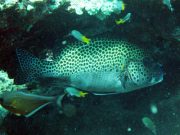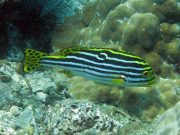Dykning med Sötläppar
Lanta Marina Liv | Plectorhynchinae
Sötläppar är lätta att känna igen på sin lilla mun, stora, köttiga läppar och distinkta färgmönster, och ses ofta under dykturer på Koh Lanta. Deras färger och mönster varierar kraftigt, från enfärgade till fläckiga, prickiga, randiga och strimmiga.
Dessa bottenlevande gruntfiskar är normalt ensamma eller lever i små grupper eller par. De är komprimerade fiskar med ett starkt utåtböjt huvud och en grop i hakan. Sweetlips genomgår en rad dramatiska färg- och mönsterförändringar under sitt liv, och ungfiskarna ser helt annorlunda ut än de vuxna.
Sötläppar kan ofta ses i små grupper under överhäng, avsatser eller andra gömställen och kan ibland umgås med andra sötläppar. Dessa fiskar är bottenätande rovdjur och på natten söker de efter bottenlevande ryggradslösa byten, såsom borstmaskar, räkor och små krabbor.
3 arter finns på denna sida:
Gold-spotted Sweetlips
(Plectorhinchus flavomaculatus)

Plectorhinchus flavomaculatus @ Hin Bida
The Gold-Spotted Sweetlips has a generally light grey coloured body, with yellowish-gold stripes and spots on the head and small yellowish-gold spots on the upper body, extending onto the dorsal and tail fins. Spots on the fins are often darker. There is a dusky lower margin on the tail fin.
The Gold-Spotted Sweetlips grows to 60 cm, but more usually observed 25 cm - 30 cm. This species is observed solitary, or in small groups and the diet includes small fish and crustaceans.
Harlequin Sweetlips
(Plectorhinchus chaetodonoides)
The Harlequin Sweetlips exhibits wildly contrasting colouring at various stages of its life, with the adult coloration and pattern being very different to the juvenile colouration.
The adult Harlequin Sweetlips has a whitish to yellowish or greenish body, with many small dark brown spots on the head, body and fins. The belly is whitish - greyish, and without spots.

Adult Plectorhinchus chaetodonoides @ Koh Bida
Sub-adult Harlequin Sweetlips are in the transition stage from juvenile to adult and have a whitish body occasionally with yellowish or greenish tinting on the back. The darker body patterns are reminiscent of the juvenile patterns, but starting to fade. The body and tail fin are covered in many small brown spots.
Juvenile Harlequin Sweetlips have a brown body and several large creamy-white, dark-edged blotches. The fins have white margins. Juveniles swim face-down, with a strange undulating, or wave-like wiggle, moving their fins in opposing circular movements. This strange dance is designed to look like a poisonous flatworm or nudibranch in order to deter predators.
Adults can reach 72 cm, but more often observed in the 30 cm range. This species is nocturnal, usually solitary and can be found near ledges on the reef edge. The diet includes crustaceans, molluscs, and fish.
Oriental Sweetlips
(Plectorhinchus vittatus)

Plectorhinchus vittatus @ Koh Bida
The Oriental Sweetlips has a pale grey to white body with black stripes and a yellow face. The black stripes are usually wider on the upper part of the body. All of the fins are yellow, with the dorsal, anal and tail fins having black blotches and spots.
The Oriental Sweetlips can grow to 85 cm, but more usually observed around 25 cm - 30 cm. This is a nocturnal feeder, whose diet includes other smaller fish. Usually encountered solitary, but may form small groups.
Dykning med Sötläppar runt Koh Lanta
Dykning och Snorkelutflykter
Om du vill ha en chans att se Sötläppar på en av våra dagliga högsäsongs dykresor från Koh Lanta, skicka oss ett e-postmeddelande till info@diveandrelax.com.
Följ med på våra dykresor med speedboat under högsäsong till några av Thailands bästa dykplatser och njut av små grupper, korta restider och fokus på personlig service, säkerhet och nöje.
Är du ännu inte certifierad dykare? Lär dig att dyka på Koh Lanta med den 3-dagars SSI Open Water Diver-kursen.
Boka online och spara 10 % på dykresor och dykkurser på Koh Lanta.
Ta Reda på Mer
Guider för Marina Djur och Växter i Indo-Stilla Havet
- Allen, G., Steene, R., Humann, P., DeLoach, N. (2003) Reef Fish Identification, Tropical Pacific. Jacksonville, FL., USA: New World Publications, Inc., ISBN 1-878348-36-1.
- Humann, P., DeLoach, N., (2010) Reef Creature Identification, Tropical Pacific. Jacksonville, FL., USA: New World Publications Inc., ISBN 978-1-878348-44-9
- Debelius, H. (2013) Indian Ocean Reef Guide. Frankfurt, Germany: IKAN - Unterwasserarchiv, ISBN 978-3-939767-52-7.
- Debelius, H. (2004) Nudibranchs and Sea Snails, Indo-Pacific Field Guide. Frankfurt, Germany: IKAN - Unterwasserarchiv, ISBN 3-925919-51-1
- Erhardt, H., Knop, D. (2015) Corals Indo-Pacific Field Guide. Frankfurt, Germany: IKAN - Unterwasserarchiv, ISBN 3-925919-69-4.
- Veron J.E.N., Stafford-Smith M.G., Turak E. and DeVantier L.M. (2016). Corals of the World


